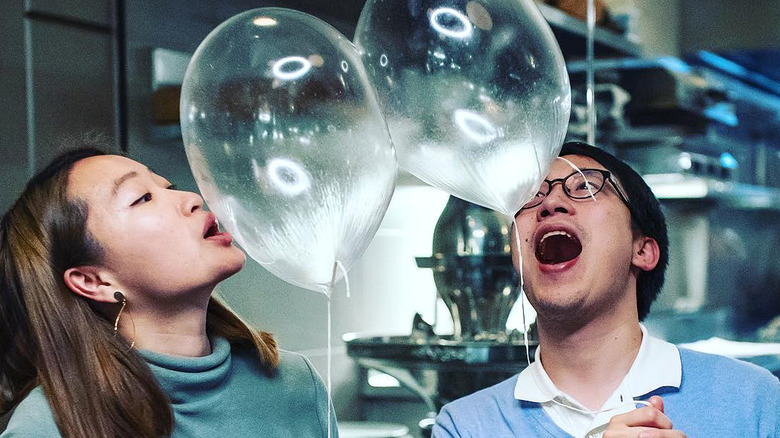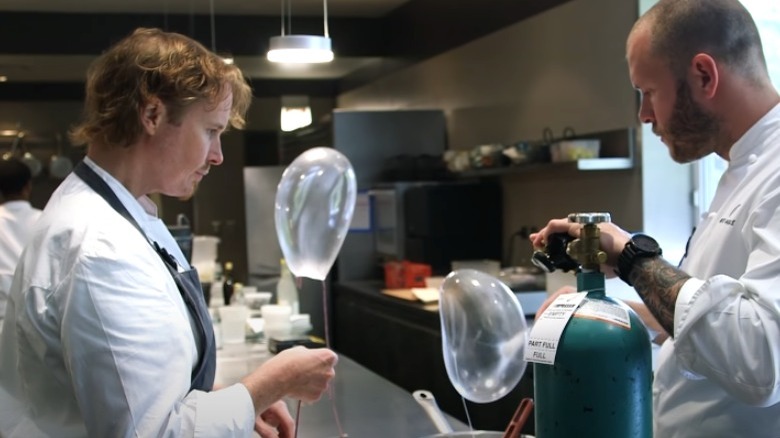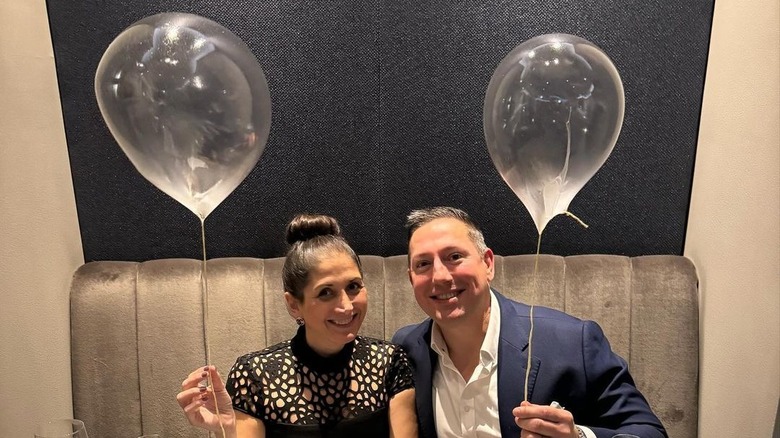Edible Helium Balloons Are A Huge Win For Annoying People
Depending on what you consider to be amusing, you'll either find edible helium balloons to be really fun or super annoying. The premise is simple enough — balloons made of edible ingredients similar to fruit-flavored taffy and are filled with helium gas, which you're then supposed to eat while inhaling the helium that's trapped inside. Breathing in helium causes your voice to go up in frequency, resulting in a very funny-sounding, cartoonishly high-pitched, squeaky way of talking and laughing — it only lasts for a few seconds until you breathe regular oxygen again, and then your voice returns to normal.
@rebeccarogersofficial Oh nooooo🤣🤣🤣
Commenters on TikTok compare the vocal change as sounding like Elmo from "Sesame Street," Bernadette from "The Big Bang Theory," and Kitty Forman, the mom character on "That '70s Show." Only a few seem old enough to recall the irritating sped-up voices of the original "Alvin and The Chipmunks."
Party planners have taken this concept of combining something tasty with something outrageously silly and turned it into a lucrative service that is available to rent for entertainment purposes. From corporate events, conferences, fairs, festivals, weddings, birthday parties, and Bar Mitzvahs, just about any gathering can offer an edible balloon station and is fair game for annoying anyone within earshot. There's even a company based in Oxfordshire, England called Lick Me I'm Delicious, which created a portable machine for making them. The first edible helium balloon, however, was actually invented at a world-famous three-Michelin star restaurant.
The origin of floating food
While party services offering edible balloons these days seem like a dime a dozen, Chef Grant Achatz has a high-end Chicago restaurant, Alinea, which originated the concept in 2012. Specifically, it was the restaurant's head chef at the time, Mike Bagale, who pioneered this unique floating dish. As he describes on Instagram, it was inspired by the edible bubbles in "Willy Wonka."
While the floating balloons on the end of a string may seem simple enough, making them from food that is both capable of enclosing helium gas without leaking as well as tasting good wasn't easy. Using techniques of molecular gastronomy, the balloons are made from fruit-flavored sugar syrup — green apple being the flavor most often served at the restaurant — and even the strings that tie them are edible, made from thin strips of dried apples. The results are large, symmetrical, and nearly crystal-clear balloons that are whimsical and beautiful. The kind you are more likely to find at parties may be made out of gelatin or other ingredients that don't capture that same see-through quality and often turn out small and misshapen.
Those copycats might be as close as some of us will ever get though. Not only is Alinea one of the busiest restaurants in the U.S., it's also one of the most expensive. Serving only a chef's choice tasting menu, a full-course meal at the restaurant can cost up to $495 per person, according to Time Out.
Are edible helium balloons safe?
Whether at a bachelorette party or one of the world's most highfalutin restaurants, edible helium balloons do raise some questions, such as: Are they dangerous? While the hilarious effect helium has on our voices is mostly considered harmless, there are some risks associated with huffing the gas to consider.
Inhaling helium displaces oxygen in our lungs. When you breathe helium instead of oxygen, it's possible to feel lightheaded or dizzy. It can also cause nausea, headaches, and more serious reactions such as fainting, seizures, embolisms, and in extreme cases, death (per Healthline). Generally, the small amount taken in from one balloon is not likely to trigger such reactions, but dangerous complications may occur from inhaling large amounts or breathing helium directly from a pressurized tank. Children should always be supervised around helium, and it is not advised even in small amounts for those under six years of age.
Another fact about helium is that our supply of it on Earth is running out. Even though it's one of the most abundant elements in the universe, the supply on our planet is limited, non-renewable, and difficult to extract. Its primary uses for purposes other than party balloons range from quantum physics, space flight, and magnet coolant for superconductors as well as in MRI machines used in medicine. The amount of helium used in balloons is far from the main cause of its depletion, so those of us who love annoying our friends needn't panic — yet.



